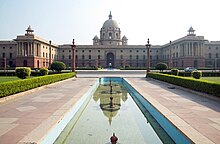Indian Ministry of External Affairs

|
|
 South Block building, housing the Cabinet Secretariat |
|
| Ministry overview | |
|---|---|
| Formed | 2 September 1946 |
| Jurisdiction | Republic of India |
| Headquarters |
Cabinet Secretariat Raisina Hill, New Delhi |
| Employees | 9,294(2016 est.) |
| Annual budget | ₹15,011 crore (US$2.3 billion) (2018-19 est.) |
| Minister responsible | |
| Deputy Ministers responsible |
|
| Ministry executives |
|
| Website | www |
The Ministry of External Affairs of India (abbreviated as MEA), also known as the Foreign Ministry, is the government agency responsible for the conduct of foreign relations of India. The Ministry comes under Government of India and is responsible for the country's representation in the United Nations. It also advises other Ministries and State Governments when the latter have dealings with foreign governments or institutions.
The Ministry was initially the Ministry of External Affairs and Commonwealth Relations, a holdover from the British Raj. It was renamed the Ministry of External Affairs in 1948. Prime Minister Jawaharlal Nehru held the portfolio as an additional charge till his death in 1964 and it was only then that a separate Minister with Cabinet rank was appointed. The ministry is responsible for the administration of Naga Hills, Tuensang Area, Indian Emigration Act of 1923, the Reciprocity Act of 1943, the Port Haj Committee Act of 1932, the Indian Merchant Shipping Act in so far as it relates to pilgrim ships, the Indian Pilgrim Shipping Rules of 1933, the Protection of Pilgrims Act of 1887 (Bombay) and the Protection of the Mohammedan Pilgrims Act of 1896 (Bengal) are also the special responsibility of the Ministry of External Affairs.
The Ministry is the cadre controlling authority of the Indian Foreign Service, the service is wholly under the administration and supervision of the External Affairs Ministry.
The Secretary General was the senior most official in the ministry till the post was abolished in 1964. The delineation of responsibilities up to that time was as follows:
The Foreign Secretary is the senior most civil servant who is the head of the Department of Foreign Affairs, and is supported by other secretary level officers.
Development Partnership Administration is an agency under the Ministry of External Affairs. As India increased its strategic footprint, DPA was formed in 2013 for effective execution of projects with professionals from diverse backgrounds. India has an elaborate project portfolio in its neighbourhood, including Bhutan, Nepal, Afghanistan, Maldives, Sri Lanka, and Bangladesh, as well as Africa and Latin America.
...
Wikipedia
